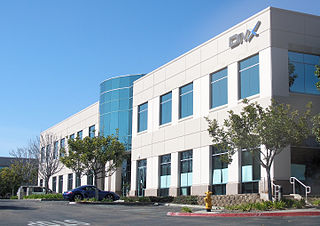A codec is a device or computer program that encodes or decodes a data stream or signal. Codec is a portmanteau of coder/decoder.
Dirac is an open and royalty-free video compression format, specification and software video codec developed by BBC Research & Development. Dirac aimed to provide high-quality video compression for Ultra HDTV and competed with existing formats such as H.264.

Xvid is a video codec library following the MPEG-4 video coding standard, specifically MPEG-4 Part 2 Advanced Simple Profile (ASP). It uses ASP features such as b-frames, global and quarter pixel motion compensation, lumi masking, trellis quantization, and H.263, MPEG and custom quantization matrices.
Windows Media Video (WMV) is a series of video codecs and their corresponding video coding formats developed by Microsoft. It is part of the Windows Media framework. WMV consists of three distinct codecs: The original video compression technology known as WMV, was originally designed for Internet streaming applications, as a competitor to RealVideo. The other compression technologies, WMV Screen and WMV Image, cater for specialized content. After standardization by the Society of Motion Picture and Television Engineers (SMPTE), WMV version 9 was adapted for physical-delivery formats such as HD DVD and Blu-ray Disc and became known as VC-1. Microsoft also developed a digital container format called Advanced Systems Format to store video encoded by Windows Media Video.
Nero Digital is a brand name applied to a suite of MPEG-4-compatible video and audio compression codecs developed by Nero AG of Germany and Ateme of France. The audio codecs are integrated into the Nero Digital Audio+ audio encoding tool for Microsoft Windows, and the audio & video codecs are integrated into Nero's Recode DVD ripping software.

DivX, LLC is a privately held video technology company based in San Diego, California. DivX, LLC is best known as a producer of three codecs: an MPEG-4 Part 2-based codec, the H.264/MPEG-4 AVC DivX Plus codec and the High Efficiency Video Coding DivX HEVC Ultra HD codec. The company's software has been downloaded over 1 billion times since January 2003. DivX, LLC's offerings have expanded beyond the codec to include software for viewing and authoring DivX-encoded video. DivX, LLC also licenses its technologies to manufacturers of consumer electronics devices and components used in these devices, of which over 1 billion DivX-enabled devices have shipped worldwide. DivX certifies that these licensed products are able to properly play DivX-encoded video.

ffdshow is an open-source unmaintained codec library that is mainly used for decoding of video in the MPEG-4 ASP and H.264/MPEG-4 AVC video formats, but it supports numerous other video and audio formats as well. It is free software released under GNU General Public License 2.0, runs on Windows, and is implemented as a Video for Windows (VFW) codec and a DirectShow filter.

XDCAM is a series of products for digital recording using random access solid-state memory media, introduced by Sony in 2003. Four different product lines – the XDCAM SD, XDCAM HD, XDCAM EX and XDCAM HD422 – differ in types of encoder used, frame size, container type and in recording media.
A container format or metafile is a file format that allows multiple data streams to be embedded into a single file, usually along with metadata for identifying and further detailing those streams. Notable examples of container formats include archive files and formats used for multimedia playback. Among the earliest cross-platform container formats were Distinguished Encoding Rules and the 1985 Interchange File Format.
TMPGEnc or TSUNAMI MPEG Encoder is a video transcoder software application primarily for encoding video files to VCD and SVCD-compliant MPEG video formats and was developed by Hiroyuki Hori and Pegasys Inc. TMPGEnc can also refer to the family of software video encoders created after the success of the original TMPGEnc encoder. These include: TMPGEnc Plus, TMPGEnc Free Version, TMPGenc Video Mastering Works, TMPGEnc Authoring Works, TMPGEnc MovieStyle and TMPGEnc MPEG Editor. TMPGEnc products run on Microsoft Windows.
These tables compare features of multimedia container formats, most often used for storing or streaming digital video or digital audio content. To see which multimedia players support which container format, look at comparison of media players.

The Core Pocket Media Player (TCPMP) is a software media player which operates on portable devices and Windows-based PCs. It is discontinued, but still available from the official mirror site. Supported operating systems include Palm OS, Symbian OS, and Microsoft Windows, CE, and Mobile. It is also available on Microsoft's Zune HD via a hack called Liberate. TCPMP also has hardware accelerated playback for ATI and Intel 2700G mobiles, such as the Tapwave Zodiac and Dell Axim X50v/X51V.

The Combined Community Codec Pack, more commonly referred to by its acronym CCCP, is a collection of codecs packed for Microsoft Windows, designed originally for the playback of anime fansubs. The CCCP was developed and maintained by members of various fansubbing groups.
The following tables compare general and technical information for a variety of audio coding formats.
Α video codec is software or a device that provides encoding and decoding for digital video, and which may or may not include the use of video compression and/or decompression. Most codecs are typically implementations of video coding formats.
Media Foundation (MF) is a COM-based multimedia framework pipeline and infrastructure platform for digital media in Windows Vista, Windows 7, Windows 8, Windows 8.1, Windows 10, and Windows 11. It is the intended replacement for Microsoft DirectShow, Windows Media SDK, DirectX Media Objects (DMOs) and all other so-called "legacy" multimedia APIs such as Audio Compression Manager (ACM) and Video for Windows (VfW). The existing DirectShow technology is intended to be replaced by Media Foundation step-by-step, starting with a few features. For some time there will be a co-existence of Media Foundation and DirectShow. Media Foundation will not be available for previous Windows versions, including Windows XP.

Stage6 was a video sharing website owned and operated by DivX, Inc., where users could upload, share, and view video clips. Stage6 was different from other video services in that it streamed high quality video clips that were user-encoded with DivX and Xvid video codecs.
Jérôme Rota is a French software developer. He is also known by the name Gej.
DivX Plus HD, launched in 2009, is the brand name for the file type that DivX, Inc. has chosen for their high definition video format. DivX Plus HD files consist of high definition H.264/MPEG-4 AVC video with surround sound Advanced Audio Coding (AAC) audio, wrapped up in the open-standard Matroska container, identified by the .mkv file extension. DivX Plus HD files leverage and extend on Matroska's ability to support multiple language tracks, subtitles, chapters, and additional bonus content.

MediaInfo is a free, cross-platform and open-source program that displays technical information about media files, as well as tag information for many audio and video files. It is used in many programs such as XMedia Recode, MediaCoder, eMule, and K-Lite Codec Pack. It can be easily integrated into any program using a supplied MediaInfo.dll. MediaInfo supports popular video formats as well as lesser known or emerging formats. In 2012 MediaInfo 0.7.57 was also distributed in the PortableApps format.









